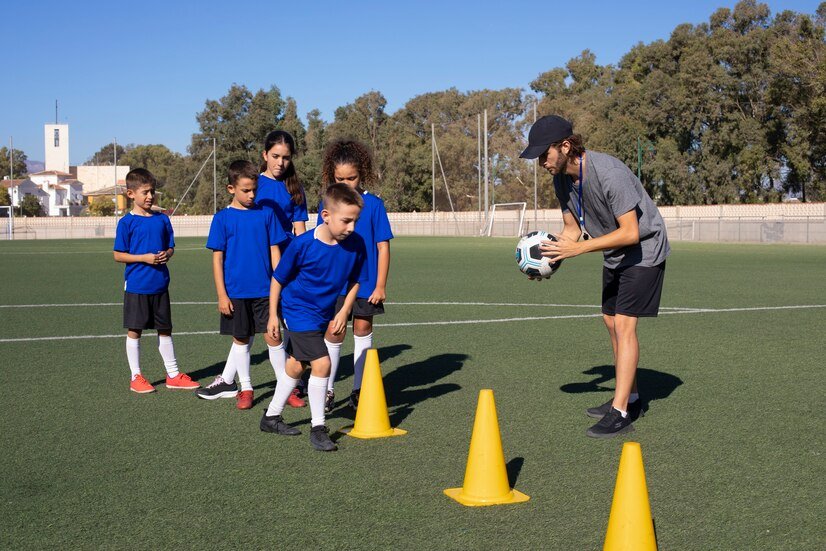In football, agility and the ability to change direction quickly are just as crucial as speed. Being able to pivot, twist, and move fluidly while maintaining control of the ball is what separates good players from elite ones. Whether you’re dodging a defender, creating space for a pass, or racing down the wing, mastering your change of direction is key to outperforming your opponents on the field.
In this detailed blog, we’ll explore how to enhance your ability to change direction swiftly and efficiently. From specific exercises to core principles of agility, we will cover everything you need to know to sharpen your directional movement, helping you stay a step ahead in the game.
The Importance of Change of Direction in Football
Football isn’t played in a straight line. Every moment of the game involves quick cuts, turns, and sudden movements that require sharp control of both the body and the ball. Players who can change direction quickly are more versatile on the pitch, as they can:
- Escape defenders: A quick change of direction can break through tightly packed defensive lines.
- Create scoring opportunities: Being able to turn sharply and pivot into space opens up the field for creative plays.
- Improve ball control: Moving fluidly with the ball helps to maintain possession under pressure.
- Recover defensively: In defensive situations, being able to change direction swiftly helps in tracking back and marking attackers effectively.
Understanding these advantages is the first step in realizing the importance of training for improved agility and direction change.
Factors That Influence Change of Direction
To master your directional movement, it’s important to understand the physical components that makeup agility in football:
1. Balance and Coordination
Changing direction requires excellent balance to keep your body in control when you shift momentum. Maintaining balance while making quick cuts or turns helps you stay grounded, especially when defenders are trying to push you off the ball.
2. Core Strength
A strong core is essential for stability and control. It acts as the foundation for almost every movement in football. When changing direction, your core helps maintain balance while allowing for quick and sharp movements.
3. Lower Body Strength
Strong legs, particularly your quads, hamstrings, calves, and glutes, are essential for the acceleration and deceleration needed when making swift directional changes. The more strength you have in your legs, the more power you can generate to pivot or sprint in another direction.
4. Agility
Agility refers to the ability to change direction without losing momentum. It requires both physical and mental agility, as you need to anticipate and react to your opponents and the ball.
5. Footwork
Quick, precise footwork allows you to control the ball and make sharp movements. Developing good footwork skills is crucial for improving your agility and change of direction on the pitch.
6. Flexibility
A flexible body allows for smoother and quicker changes in movement. Improving your flexibility will help reduce the risk of injury when making sharp cuts or turns and can enhance your overall agility.
Now that you know the components, let’s look at how to improve your change of direction on the field.
Drills to Improve Change of Direction
To become agile and quick on your feet, you need to practice drills that target specific movements related to directional changes in football. Below are several tried-and-tested drills to improve your ability to change direction with speed and control.
1. Cone Agility Drill
The cone drill is a staple in football training and helps players develop sharp directional movements. It improves your ability to change direction quickly while maintaining balance and speed.
How to Perform the Cone Drill:
- Set up five cones in a straight line, each 5-10 yards apart.
- Start at one end, sprint to the first cone, and make a sharp cut to the left or right toward the next cone.
- Sprint to the second cone and change direction again, continuing through all five cones.
- Focus on lowering your center of gravity and maintaining control during each directional change.
- Repeat the drill at varying speeds, increasing intensity as you improve.
2. Zig-Zag Dribbling Drill
Dribbling through a zig-zag pattern of cones helps improve your ball control while changing direction. This drill simulates a game scenario where you need to navigate through defenders while maintaining possession of the ball.
How to Perform the Zig-Zag Dribbling Drill:
- Set up cones in a zig-zag pattern, spaced about 5 yards apart.
- Dribble the ball around each cone, alternating direction at each turn.
- Use both feet to dribble and change direction to improve your versatility and control.
- Focus on tight touches, keeping the ball close to your feet as you make sharp cuts around each cone.
3. Ladder Drills for Agility
Agility ladders are an excellent tool for improving foot speed and coordination, both of which are essential for changing direction quickly. The focus here is on quick, precise footwork that helps build your reaction time and movement efficiency.
How to Perform Ladder Drills:
- Place an agility ladder on the ground.
- Start at one end and run through the ladder, placing one foot in each square and moving quickly.
- Use different patterns, such as two feet in each square, side shuffles, or crossover steps.
- Maintain a low stance and work on speeding up your foot movements while keeping your upper body controlled.
- Add variations, such as sprinting in one direction after completing the ladder, to simulate game-like conditions.
4. Sprint and Backpedal Drill
This drill improves your ability to accelerate and decelerate, two key aspects of changing direction in football. The ability to stop quickly, pivot, and move in the opposite direction is crucial when tracking an opponent or repositioning yourself during play.
How to Perform the Sprint and Backpedal Drill:
- Set up two cones about 10-15 yards apart.
- Start by sprinting to the first cone.
- As you reach the cone, quickly plant your foot, pivot, and backpedal to the starting point.
- Repeat the sprint and backpedal sequence several times, focusing on making smooth, quick transitions between each movement.
5. Side-to-Side Shuttle Drill
The shuttle drill focuses on lateral movement, helping you improve your side-to-side agility. This is particularly useful for defenders and midfielders who need to track opponents across the field.
How to Perform the Shuttle Drill:
- Set up three cones in a straight line, spaced about 5 yards apart.
- Start at the middle cone and shuffle laterally to the cone on one end.
- Once you reach the end cone, quickly shuffle to the cone on the opposite end.
- Continue shuffling from side to side, staying low and keeping your feet light and quick.
Improving Core Strength for Better Agility
A strong core helps maintain balance and control during quick changes of direction. Here are a few exercises to improve core strength, which is essential for football agility:
1. Plank Variations
Planks are excellent for building core stability. Try different plank variations, such as side planks or dynamic planks, to engage your entire core and improve balance.
How to Perform a Plank:
- Lie face down on the ground, resting on your forearms.
- Lift your body, keeping a straight line from your head to your heels.
- Engage your core and hold the position for as long as possible, focusing on maintaining good form.
2. Russian Twists
Russian twists are great for improving rotational core strength, which is essential for pivoting and turning in football.
How to Perform Russian Twists:
- Sit on the ground with your knees bent and feet off the floor.
- Hold a weight or a football in both hands, and rotate your torso from side to side, tapping the ball on each side of your body.
3. Bicycle Crunches
Bicycle crunches engage your entire core, with a focus on your obliques, which are crucial for lateral movements and directional changes.
How to Perform Bicycle Crunches:
- Lie on your back with your hands behind your head and your legs lifted off the ground.
- Alternate bringing one knee toward your chest while twisting your opposite elbow toward the knee.
- Repeat on the other side, mimicking a pedaling motion.
Tips for Improving Agility and Change of Direction
Here are a few additional tips to help you get the most out of your change of direction training:
1. Focus on Deceleration
Improving your deceleration is just as important as acceleration. Being able to stop quickly and maintain control will allow you to change direction more efficiently. Work on decelerating smoothly by lowering your center of gravity, bending your knees, and planting your feet firmly when stopping.
2. Maintain a Low Stance
When changing direction, stay low to the ground. A lower stance gives you more balance and allows you to push off more explosively. Bend your knees slightly and keep your torso upright as you shift direction.
3. Practice Reaction Time
Quick reactions are essential for changing direction during a game. Work on improving your reaction time with drills that require you to respond to external cues, such as a coach’s command or a ball being thrown in your path.
4. Wear Proper Footwear
Ensure that you’re wearing the right footwear for the type of surface you’re playing on. Cleats that provide good traction are critical for executing quick changes of direction on natural or artificial grass surfaces. Proper footwear helps prevent slipping and allows for smoother, sharper movements.
5. Stay Agile Mentally
Football is not just a physical game but a mental one. Being able to read the game, anticipate your opponent’s movements, and react quickly is crucial to improving your agility and change of direction on the field. Practice mindfulness and visualization techniques to prepare your mind for quick, sharp movements.
Conclusion
The ability to change direction swiftly and efficiently is a critical skill in football. Whether you’re an attacker looking to outmaneuver defenders or a midfielder tasked with controlling the pace of the game, improving your agility and change of direction can take your performance to the next level.
At our football academy, we focus on incorporating specific drills like the cone drill, ladder exercises, and zig-zag dribbling into your training regimen. By strengthening your core and lower body, you’ll enhance your speed, balance, and footwork. Combining these physical improvements with mental agility and proper game awareness will make you an unpredictable and formidable presence on the field.
Start working on these drills today and watch your change of direction in football improve, allowing you to become a more dynamic and effective player!




